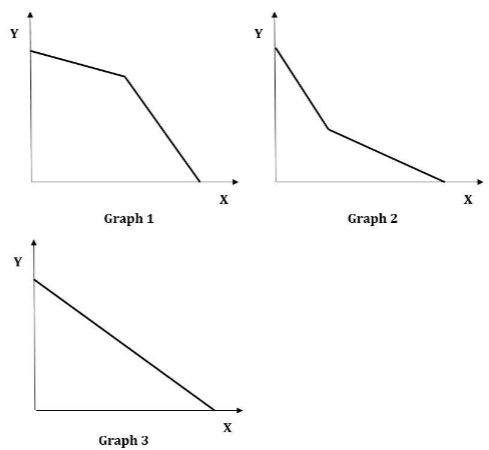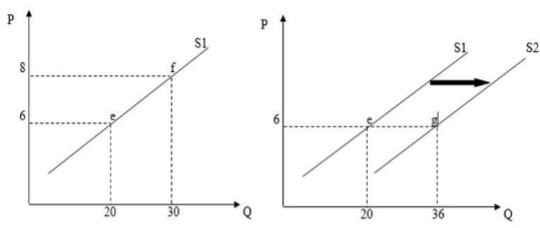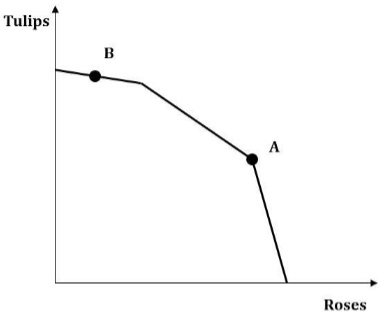Binary Choice:
Question 1. Michael has been stuck at a part - time job he dislikes for four years. He has spent these years constantly searching for a better option but has been unable to find one. Is he unemployed?
a) Yes, he is unemployed.
b) No, he is not unemployed.
Question 2. Which of the following statements is true?
a) If the nominal GDP growth rate is negative, then the quantities of final goods and services domestically produced this year are smaller than the quantities produced last year.
b) If GDP grows, then the Production Possibilities Frontier is shifting out .
Question 3. More unemployment increases income inequality.
a) This statement must be true.
b) This statement may not be true.
Question 4. If the GDP deflator doubles, it indicates that:
a) The output adjusted for number of workers has doubled.
b) Price levels have doubled.
Question 5. If the government announces today that a tax increase of 50 cents per pack of cigarettes is to take place in two weeks, what would you expect to happen today to the current market for cigarettes?
a) The demand for cigarettes would increase.
b) The price of cigarettes would decrease.
Question 6. Inventories are stocks of goods and raw materials held to facilitate business operations. According to the national accounts system, changes to inventories
a) would be included as a component of investment spending.
b) would not be included as a component of investment spending.
Question 7. Which of the following factors could cause the demand curve for labor to shift to the right?
a) The price of capital increases.
b) The wage rate increases .
Question 8. Countries A and B Produce only goods X and Y. If the countries trade optimally, which of the following graphs could represent the joint PPF of countries A and B?

a) Graphs 1, 2, and 3.
b) Graphs 1 and 3.
Question 9. “The United States will have more debt than France next year.” This is an example of a _____ statement.
a) Positive
b) Normative
Question 10. Refer to the graph below. Which of the following movements depicted in the two graph s best describes a change in supply caused by a decrease in the cost of inputs ?

a) The movement from e to f on the graph on the left side.
b) The movement from e to g on the graph on the right side
Multiple Choice:
Question 11. The GDP is the market value of all the final goods and services
a) produced domestically.
b) produced by domestically owned factors of production.
c) produced by all factors of production.
d) bought by consumers during the time period under consideration.
e) Answers (a), (b), (c) and (d) are all true about GDP.
Question 12. Consider the market for automobiles. Suppose the demand equation for an individual consumer in this market is given by the equation P = 2000 – 2Q . If there are 100 identical consumers in the market for automobiles , what is the equation for the market demand curve in slope - intercept form ?
a) P = 2000 – 0.02Q
b) P = 20 – 0.02Q
c) P = 200,000 – 200Q
d) P = 2000 – 200Q
e) P = 200,000 - 0 .02Q
Question 13. Which of the following scenarios is an example that illustrates the concept of structural unemployment?
a) Snow ski instructors being out of work every summer.
b) People choosing to not work due to an increase in the benefits they receive from welfare.
c) A car manufacturing worker in Detroit is currently not getting paid due to a labor - management dispute that has resulted in autoworkers not working.
d) After a stock market crash, people start saving to rebuild their lost wealth. Due to this saving, d emand for prod ucts today is weak and so employers reduce the number of people they employ.
e) Stanley and Alice both graduated from college in December and they are still looking to find a job that matches their skills and talents.
Question 14 . A medical society has recently announced that a glass of red wine in the evening can reduce the risk of heart disease. An arc tic front has caused a large freeze in Central California and greatly reduced the crop of grapes. Given this information and holding everything else constant, what will happen in the market for red wine? Relative to the initial equilibrium price and equilibrium quantity,
a) the equilibrium price will increase , and the equilibrium quantity will be indeterminate.
b) the equilibrium price will decrease , and the equilibrium quantity will be indeterminate.
c) the equilibrium quantity will increase, and the equilibrium price will be indeterminate.
d) the equilibrium quantity will decrease, and the equilibrium price will be indeterminate.
e) both the equilibrium price and the equilibrium quantity will be indeterminate.
Question 15. Gadget producers in Utopia are distressed that their gadgets are selling for very low prices. The gadget producers successfully lobby the government of Utopia to enact an effective price floor in the market for gadgets. Given this information, which of the following statements is true?
a) People in Utopia will keep buying the same amount of gadgets as they did before the price floor because no one will want to go through the d ay without their gadget.
b) People in Utopia will all think this price floor is a great idea since it will help the gadget producers.
c) People in Utopia will purchase even more gadgets once the effective price floor is enacted since the price floor will help th em recognize just how valuable a gadget is.
d) People in Utopia will purchase the same amount of gadgets as they did before the enactment of the price floor because the price floor is effective.
e) People in Utopia will lose part of their consumer surplus: gadget producers will capture part of this surplus once this price floor is enacted.
Question 16. Maria, George, and Farah produce roses and tulips. Maria has a comparative advantage over her friends George and Farah in producing roses, and George has a comparative advantage over Farah in producing tulips. The following graph shows th eir combined PPF. Which of the following statements is true?

a) Movement from point A to point B could occur if Farah produces more roses and fewer tulips.
b) Movement from point A to point B can occur if and only if both Maria and Farah produce more tulips and fewer roses and George keeps producing exactly the same number of roses and tulips as he was producing at point A.
c) Movement from point A to point B could occur if George produces more tulips and fewer roses.
d) Movement from point A to point B can occur if and only if both Maria and George produce more tulips and fewer roses and Farah keeps producing exactly the same number of roses and tulips as she was prod ucing at point A.
e) Movement from point A to point B could occur if Farah produces more tulips and fewer roses and Maria and George keep producing exactly the same number of roses and tulips as they were producing at point A.
Use the following information to answer the next 2 (TWO) questions. Consider the hypothetical economy consisting of three firms in the table below. Ore, Inc. and Steel, Inc. produce ore and steel, of which they sell some to Motors, Inc. and the rest directly to consumers . The ore and steel produced by Ore, Inc. and Steel, Inc. are the o nly inputs used by Motors, Inc.

Question 17. What is the GDP of this economy?
a) $3 ,5 00
b) $20,5 00
c) $23,000
d) $24 ,000
e) $33 ,000
Question 18. Which of the following statements is true?
a) In this economy the total profit of firms equals $3,500 .
b) In this economy the total profit of firms equals $14,000.
c) The value add ed of the firm Motors, Inc. is $14,000 .
d) Both a) and b) are correct.
e) Both a) and c) are correct.
Question 19 . Suppose that in a hypothetical economy there are 400 people who have jobs and 100 people who are at least 16 years old that do not have jobs. You also know that within this same economy there are 90 people who are looking for a job: some of these 90 people are unemployed and some of them are currently employed but looking for a better job . Finally, you know that in this population of people, there are 20 people who do not have jobs and have stopped looking for jobs. Given this information, how many of these people are unemployed?
a) 70 people
b) 80 people
c) 90 people
d) 100 people
e) There is not enough information to answer this question.
Use the following information to answer the next 3 (THREE) problems. Suppose that there is a small, closed economy that produces bananas and the market for bananas in this small economy can be described by the following equations where P is the price of a banana (in cents) and Q is the quantity of bananas:
Domestic Demand for Bananas: Q = 80 – (1/2)P
Domestic Supply of Bananas: Q = P – 40
Furthermore, you know that the world price of bananas is 60 cents.
Question 20. If this small economy does not open the banana market to trade, then consumer surplus is
a) twice the value of producer surplus and the equilibrium quantity of bananas is 40 bananas.
b) half the value of producer surplus and the equilibrium quantity of ban anas is 80 bananas.
c) $3.20 while the value of producer surplus is $0.80.
d) larger than it would be if the small economy opened this market to trade.
e) the same as it would be if the small economy opened this market to trade.
Question 21. Suppose this small economy opens its banana market to trade. Given the above information, which of the following statements is true?
a) Opening this market to trade is beneficial to this small economy.
b) Opening this market to trade allows domestic consumers to consume more bananas.
c) Opening this market to trade results in a movement along the domestic supply curve.
d) Answers (a) and (b) are both true statements.
e) Answers (a), (b) and (c) are all true statements.
Question 22. Suppose this small economy opens its banana market to trade and, at the same time, the government of this small economy limits the number of banana imports into the economy. Given the above information and holding everything else constant, for this import quota to be effective it must be
a) Set at a level of at least 30 bananas.
b) Set at a level of at least 60 bananas.
c) Set at a level of no more than 20 bananas.
d) Set at a level of no more than 30 bananas.
e) Set at a level of no more than 6 0 bananas.
Question 23. The number of potential workers in an economy is 4. Labor supply is given by L = W, where W is the wage. Labor Demand is given by L = 10 - W. What is the long - run unemployment rate?
a) 50 percent
b) 25 percent
c) 20 percent
d) 60 percent
e) 0 percent
Use the following information to answer the next 2 (TWO) problems. Majd and Salam can produce snowboards and skis. Every 2 hours, Majd can produce 4 snowboards and 12 skis, or he can produce 2 snowboards and 18 skis. Every hour, Salam can produce 4 snowboards and 8 skis, or he can produce 8 snowboards and no skis . Majd and Salam each work 4 hours a day.
Question 24. Working together, what is the maximum number of skis that Majd and Salam can produce in two days?
a) 224 skis
b) 112 skis
c) 320 skis
d) 168 skis
e) 96 skis
Question 25. If Majd and Salam decide to trade with each other, what range of prices in terms of skis would be acceptable to both parties for 5 snowboards?
a) between 10 and 15 skis
b) between 2 and 3 skis
c) between 1/15 and 1/10 skis
d) between 1/3 and 1/2 skis
e) between 5/3 a nd 5/2 skis